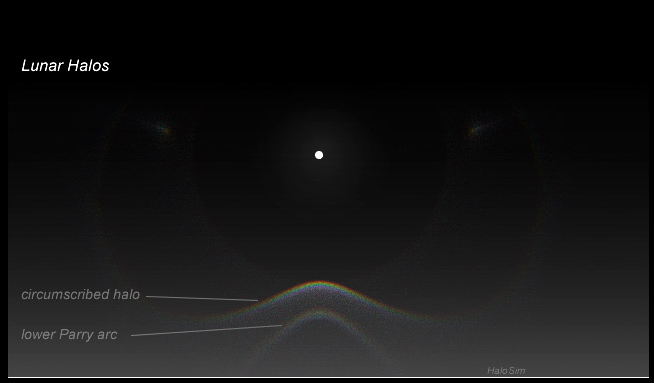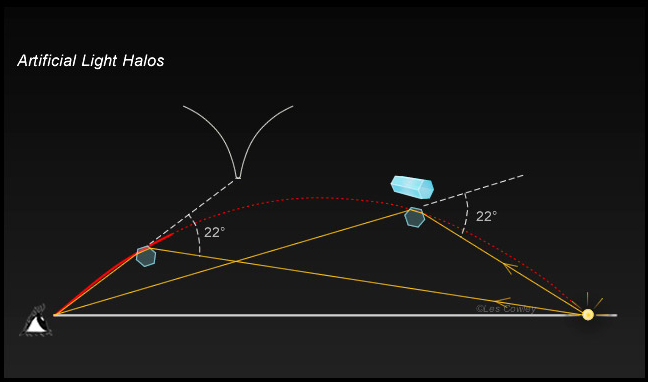OPOD - Parry & Flared Pillars
OPOD - Parry & Flared Pillars: A Rare Atmospheric Optics Phenomenon
Have you ever witnessed a mesmerizing display of lunar and light halos in the night sky? These ethereal phenomena are a sight to behold, with their captivating colors and unique features. In this article, we will explore the rare atmospheric optics display known as Parry & Flared Pillars, which was captured in an awe-inspiring photograph by Steinar Midtskogen.
Moon halos, also known as lunar halos, exhibit remarkable characteristics that make them stand out in the night sky. Directly beneath the moon, a vibrant chromatic halo can be observed. This lower tangent arc, or more precisely, the lower section of a circumscribed arc, indicates the presence of ice fog rich with horizontal column crystals. The shape of this arc reveals the alignment of these crystals in the atmosphere.
However, what makes this particular moon halo display even more extraordinary is the presence of a second halo that mimics the shape of the upper one. This rarely seen lower Parry arc, also referred to as a moonvex Parry arc, is formed by column crystals exhibiting Parry orientations. These unique crystal arrangements contribute to the creation of this secondary halo.
Moving on to light halos, we discover another fascinating optical phenomenon. In this particular case, ice crystals in the atmosphere interact with the lights of Oslo, creating an illusion of upward-going pillars of light. These pillars possess an unusual feature - fluted, trumpet-shaped tops. The formation of these pillars can be attributed to the predominance of horizontal column crystals, as evidenced by the bright lunar halo.
When light passes through the side faces of horizontal columns, it is refracted at a minimum angle of 22°, resulting in the formation of the lower tip of the upper tangent arc from either the sun or the moon. However, when it comes to nearby artificial lights, the spatial halo formed is slightly different.
To understand the formation of these fluted pillars, let's consider an Oslo light on the left side. The path where horizontal columns deflect light through 22° is marked by a dotted red curve connecting the light and the observer's eye. These glinting crystals collectively contribute to the formation of a weak apparent pillar of light. Additionally, plate crystals may also play a role in this phenomenon.
The fluted halos formed by column crystals above the parabola-shaped curve are not visible individually because those from different sections are vertically displaced. However, when these sections overlap along the linear section near the observer's eye, they strengthen each other, resulting in the distinctive flutes observed in the sky.
The photograph captured by Steinar Midtskogen showcases the beauty and complexity of these atmospheric optics phenomena. The transition from clear sky to ice fog provided a brief but stunning display of ice halos, fluted light pillars, and a bright arc below the moon. Jupiter also graces the image, adding to its celestial splendor.
In conclusion, Parry & Flared Pillars are a rare atmospheric optics phenomenon that combines moon halos and light halos to create a mesmerizing display in the night sky. The alignment of horizontal column crystals and their interaction with natural and artificial light sources contribute to the formation of these unique optical features. Capturing such moments in photographs allows us to appreciate the wonders of our atmosphere and the intricate interplay of light and ice crystals in creating these ethereal spectacles.

Oslo - Nov 17, 2010
A rare lunar and light halo display captured by Steinar Midtskogen (site). ©Steinar Midtskogen

"In the transition from clear sky to ice fog there was a brief ice halo display around 22:45 MET. There were several .fluted. light pillars and an arc below the Moon. The arc was initially very bright, but had dimmed by the time I had my camera ready. Jupiter is also visible in the picture. The temperature was -7.5C. Exposure 4s at f/4 ISO200."
Both the moon halos and light halos have rare features.
Moon halos - Directly beneath the moon is a bright chromatic halo. This is a lower tangent arc or more correctly the lower section of a circumscribed arc since the lunar altitude was 35°. The arc shows that the ice fog was rich with horizontal column crystals.
Below the circumscribed arc and crossed by a vertical light pillar is a hint of a second halo that echoes the shape of the upper one. This is a rarely seen lower (moon)vex Parry arc from column crystals additionally constrained in Parry orientations. More of Parry arcs in the next OPOD.

Light halos - ice crystals are glinting the Oslo lights towards the camera to produce the appearance - an illusion - of upward going pillars of light.
The pillars are unusual in that they have fluted, trumpet shaped, tops. The clue to their formation is the preponderance of horizontal column crystals as evidenced by the bright lunar halo.
Light passing through side faces of horizontal columns is refracted through a minimum angle of 22° to form the lower tip of the familiar upper tangent arc from the sun or moon. The corresponding spatial halo made by a nearby artificial light is a little different.
At left is an Oslo light. The dotted red curve joining the light and the eye marks the path where horizontal columns deflect light through 22°. They all glint light to form a weak apparent pillar. Some plate crystals might also be contributing. At any one point, column crystals above the parabola form a fluted halo shape but it is not visible because those from other sections are vertically displaced and the result is a faint blur.
The solid red curve section near the eye is almost linear. The fluted halos from sections along this section overlap and strengthen each other to form the flutes in the sky.
Note: this article has been automatically converted from the old site and may not appear as intended. You can find the original article here.
Reference Atmospheric Optics
If you use any of the definitions, information, or data presented on Atmospheric Optics, please copy the link or reference below to properly credit us as the reference source. Thank you!
-
<a href="https://atoptics.co.uk/blog/opod-parry-flared-pillars/">OPOD - Parry & Flared Pillars</a>
-
"OPOD - Parry & Flared Pillars". Atmospheric Optics. Accessed on July 27, 2024. https://atoptics.co.uk/blog/opod-parry-flared-pillars/.
-
"OPOD - Parry & Flared Pillars". Atmospheric Optics, https://atoptics.co.uk/blog/opod-parry-flared-pillars/. Accessed 27 July, 2024
-
OPOD - Parry & Flared Pillars. Atmospheric Optics. Retrieved from https://atoptics.co.uk/blog/opod-parry-flared-pillars/.